Why should we bother restoring a P-61 night fighter to flying condition?
Forget history. Forget the fact she'll be the only one in the world capable of flight. Forget that your humble narrator is dying to see her take off.
Let's do it because she is an incredibly beautiful thing to behold!
Here's a view of the Black Widow's fine backside from the Mid-Atlantic Air Museum's World War II Weekend June 7, 2014:
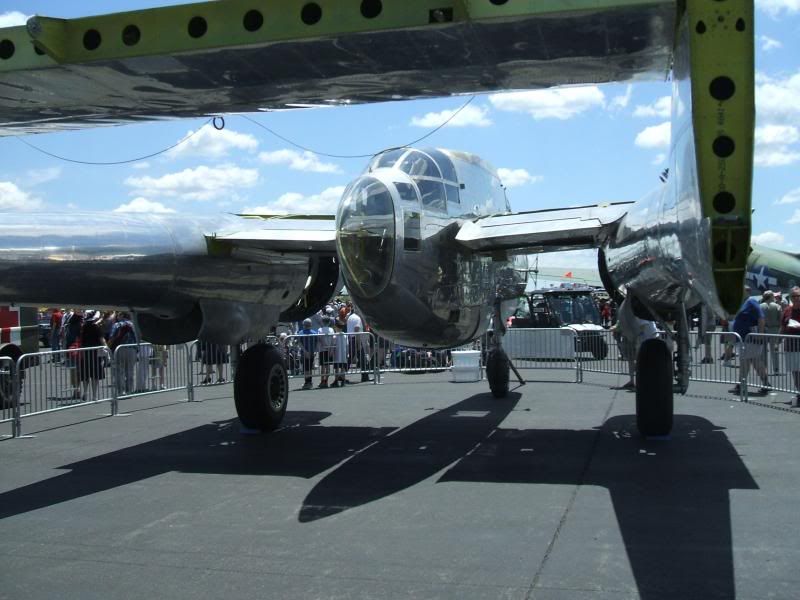
Mid Atlantic Air Museum
11 Museum Drive
Reading, PA 19605
(610) 372-7333
or visit the online store to use your credit card to donate.
Here's what she looked like when she was pulled out of the Indonesian jungle:
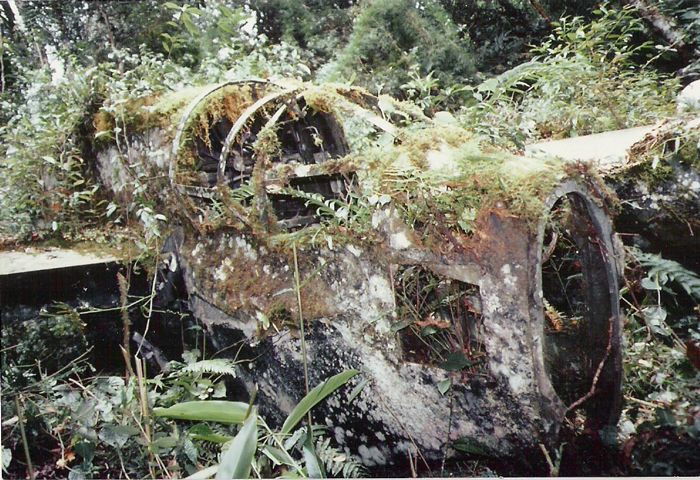
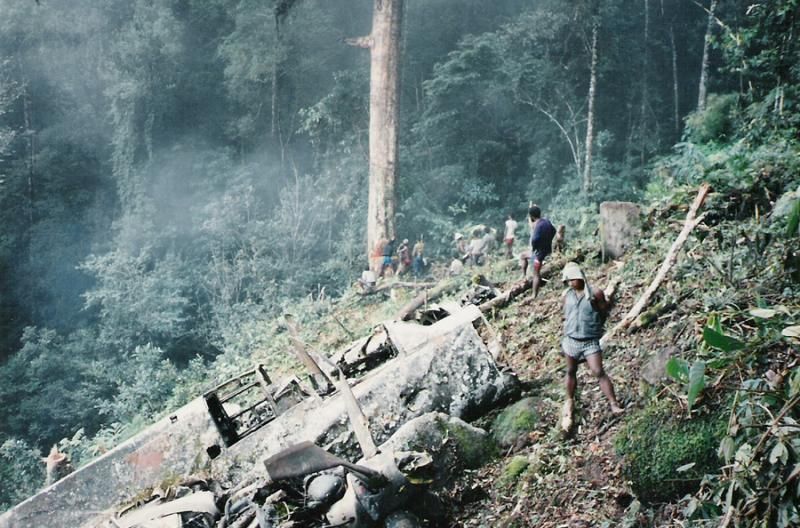

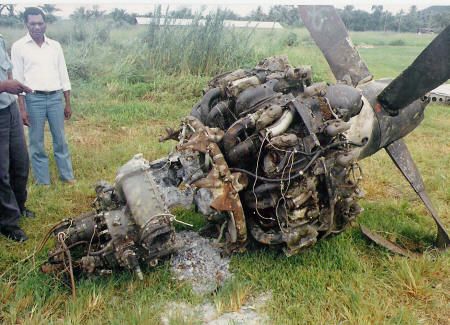
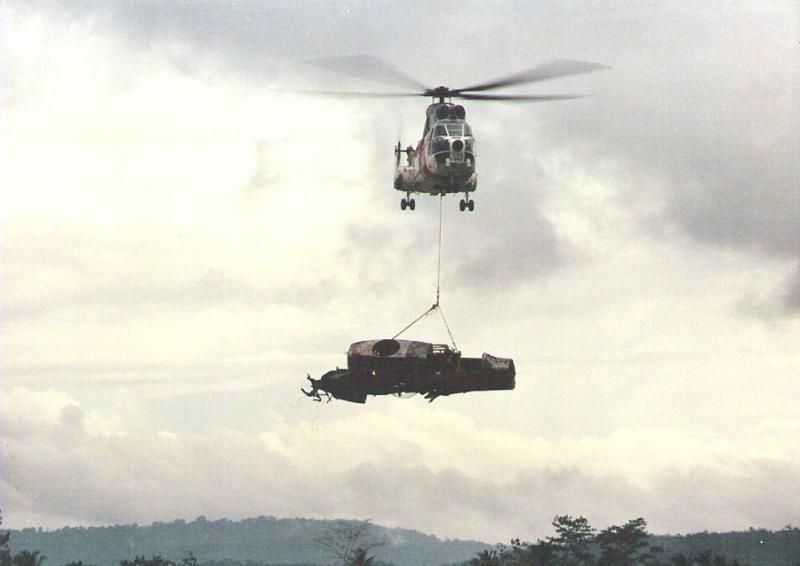
Here's the remarkable story of this beauty's recovery from The Widow's Web:
The Mid-Atlantic Air Museum was formed in 1980 for the purpose of acquiring the right to recover P-61B # 42-39445 from its mountaintop crash site. The museum's ultimate goal was to return the plane to its facility in Reading, Pennsylvania and restore it to flying condition.
with illustrations from the MAAM files
On 10 January 1945, shortly before noon, with the temperature nearing 100 degrees at the Hollandia airfield, New Guinea, a pilot, radar operator and two passengers climbed aboard their newly acquired P-61B Black Widow in order to perform a proficiency flight. The two Pratt & Whitney R-2800 engines both roared to life, the wheel chocks were pulled away and the almost 15 ton aircraft began to taxi to the end of the main runway. After the crew completed their preflight checklist the brakes were released and the aircraft began its takeoff roll down the runway and then lifted off for its flight.
At a mere two miles off the end of the Hollandia runway the summit of Mount Cyclops rose abruptly to 7000 feet above sea level. On this day the crew would put the vertical climbing performance of their new aircraft to the test. The pilot made two high speed passes low over the flat coral airstrip and then attempted to pull up and clear the 7000 foot summit of the Cyclops. With each pass the P-61 failed to clear the summit, but the pilot successfully turned away, abandoning both attempts. Upon failing to clear the summit for a second time, the pilot decided that he had to climb and gain altitude, which could be traded off for airspeed. After flying off completely out of sight for several minutes, the pilot pushed the P-61 into a full-speed dive and then reappeared for a third attempt flying by at maximum speed, whistling as it passed low over the airstrip, nearly cutting off the tops of the six foot tall kuni grass. He then pulled up and began to climb and to climb and to climb. Suddenly the twin 2000 horsepower Pratt & Whitney engines were silenced as the Black Widow stalled, clipping the tops of several trees and then pan-caking on to the side of the mountain, coming to rest on top of a large outcrop of rocks at a very precarious 55 degree angle. Surprisingly enough, only the radar operator sustained a rather severe forehead laceration. The remaining crewmembers were all lucky enough to escape the crash without major injuries.
The members of the 550th Night Fighter Squadron based at the Hollandia airfield stood helplessly and watched as the P-61 nested itself high atop the mountainside like a big black bird. There was no smoke or fire emitting from the crash site. For that reason everyone had hoped that there would be survivors aboard the plane. The Squadron Operations Officer immediately jumped into a L-5 "Sentinel" and began to gain altitude. After climbing for quite a while he was finally able to make a pass over the crash site, confirming that their were indeed survivors. Within hours two rescue teams manned with medical personal were on their way up the mountain. The rescue teams plotted their course, which pointed them directly up the steep slopes of Mt. Cyclops, then the two teams split up in an attempt to find the most accessible way to the crash site. Night soon fell and both rescue teams were forced to make camp for the evening. At first light the rescue teams continued on, with one of the teams finding that they were completely cut off do to the impassable cliffs, they were then forced to turn back. The Japanese infantry was recently forced out of the Hollandia area and evacuated, however it was suspected that some of them might have been left behind and were now roaming the mountainside. For that reason locating flares were not used at that time. After traversing up the rigorous mountainside for nearly two days, one of the rescue teams was nearing the suspected crash site. At that time they finally fired a white flare and immediately a green flare came down from the mountainside. From that point the rescue team knew that there were still survivors!
Shortly after the crash, with his radar operator bleeding profusely from his forehead, the pilot panicked and began running back down the mountain in an attempt to get help. In his haste he slipped and fell down a steep drop off, breaking his back and bones in both of his feet. Although now seriously injured, the pilot continued on and was finally picked up by medical personal at the base of the mountain late the very same day.
After the rescue team found the three remaining crewmembers near the plane, it once again was nearing nightfall so they were forced to make camp for the second evening. At first light rescuers placed the survivors on stretchers and began to descend back down the mountain, switching off every few minutes along the way. After nearly eight hours of hiking, they finally reached a point where the Army ambulance could take them back to the base hospital. Nearly three full days had elapsed by the time all of the survivors finally made it back to the base hospital.
In 1976 Russ Strine purchased the assets from a small Fixed Based Operator (FBO) and formed his own FBO. Eugene Strine, Russ's father, accepted the position of Service Manager and soon thereafter the business outgrew its small grass strip in Hanover, Pennsylvania. The following year they relocated to the former Middletown Air Depot (now Harrisburg International Airport) in Middletown, Pennsylvania. In the spring of 1978 the newly formed Mid-Atlantic Wing of the formerly known Confederate Air Force (CAF) approached the Strines for help. The two men agreed to sponsor the Wing and before long there were several new airplanes based at their facility. The Strines became quite involved in the CAF activities, participating in many air shows and getting to know their fellow warbird enthusiasts. During an air show a CAF member told Gene Strine the story of a P-61 Black Widow that was lost 12,000 miles away from home and nearly forgotten about for thirty-five years. The aircraft sat elevated on a pile of rocks deep within the towering jungle high atop Mt. Cyclops, just 300 feet short of its summit in New Guinea. He then stated that he had offered the information to the CAF for recovery purposes, but they had showed no interest in the aircraft, however Gene Strine did! At a later air show the same CAF member showed Gene photographs and hand written letters from a missionary who had seen the aircraft perched atop Mt. Cyclops in what was now Irian Jaya, Indonesia, no longer part of New Guinea.
After discussing the aircraft thoroughly with Russ, Gene felt there was enough interest in the aircraft to initiate permission for recovery since their were only three other P-61's known to still exist throughout the world and this particular aircraft only had 10 hours of total flight time logged prior to its crash. When the CAF member was asked if he would release the information to the Strines, he said he would after offering it one last time to the CAF Headquarters. He did so but the CAF didn't foresee that any serious effort would be made to obtain the aircraft. At that time everything was turned over to Gene who very quietly put his plans into motion by initiating a long series of contacts and talks with various Indonesian authorities. Streams of letters were written in the ensuing year with very little progress. The major obstacle seemed to be from officials in Indonesia who wanted to know who these Americans were and why they should be the ones to recover the P-61. The Indonesians listened, but were very cautious, with much communication between the Strines, the Indonesian Embassy, and with Jakarta, the Indonesian capital. Meanwhile, in December 1980 the Strines organized and incorporated the Mid Atlantic Air Museum (MAAM) as a 501 (c) (3) not-for-profit educational organization. The incorporation allowed the Museum to act as a legitimate body to request salvage rights for the P-61 from the Indonesians.
Finally, in 1983 the United States Air Force officially signed off in writing any interest they had in the aircraft, officially stating that the P-61 was considered one of the "spoils of war" under treaties signed ending World War II. The aircraft was thus owned by the country upon whose soil it rested. Continual contact was made with the Indonesian government and in 1984 it was agreed that some type of trade would be made between the two parties as basis for a deal. Permission was granted for museum personnel to travel to Irian Jaya, Indonesia to locate and inspect the P-61, to determine if it was worth recovering.
1984 was a very pivotal year for MAAM. Membership passed 500 and late that year it was publicly announced that MAAM had received written permission to recover the very rare aircraft. In November, Gene Strine led an exploratory expedition to assess the condition of the aircraft. Though it took jumping through the many bureaucratic hoops and tons of paper work the four man expedition group was in Sentani by Thanksgiving welcomed by their new friends from the Jungle Aviation and Radio Service, the flying arm of Wycliffe Bible Translators, whose generous help would aid the expedition team enormously throughout the recovery.
The expedition team struggled on their way up the mountain, climbing up inclines as steep as 85 degrees. After nearly nine hours of hiking and through a near Herculean effort, expedition sponsor AI Wenger and the late famed historian and aviation author Jeffery Ethell were the only inspection team members to make it all the way to the aircraft with the aid of local Dani tribesmen acting as guides. Incredibly the aircraft, although banged up when stalling through the trees, appeared to be structurally sound. The low humidity that was present at this high elevation and jungle vegetation that quickly engulfed the aircraft covering it with moss and vines, helped to prevent the onset of corrosion. Aiding to the further protection of the aircraft was the large elevated mountainside rock pile on which it was perched, thus protecting it from contact against the jungle floor. Upon closer inspection of the aircraft, some of the moss was scraped away and the aluminum below glistened, air remained in the tires, hydraulic fluid remained in the lines, gas remained in the fuel tanks and oil remained in the engines. The exploratory expedition team was elated and plans were immediately made to start the recovery efforts.
On New Year's Day 1985 Gene Strine led the first six- man recovery team back to Irian Jaya, Indonesia to begin the disassembly of the aircraft. The late Jeffery Ethell once again accompanied the first recovery team, documenting each phase of the salvage process. The first recovery expedition lasted three weeks, which included five days high atop Mt. Cyclops living in huts built for them by the local tribesmen. The first recovery team was there on top of the mountain 10 January 1985, forty-years to the day when the aircraft originally went down. The recovery team had only made minimal progress with the disassembly of the aircraft. Foremost, the team quickly learned how remote this area was and just how difficult the task would be. Second was just how extremely expensive it would be to carry out each and every expedition. Most importantly during the first recovery effort they were able to better assess the disassembly process and just how much of the jungle that would need to be cleared in order to safely helicopter the larger sections out. A second recovery team replaced the first shortly after they left the site, bringing with them many needed tools and supplies that were not locally available.
The Indonesian bureaucracy was responsible for so much wasted time and effort, as the recovery team would spend days waiting for permission to work from the Indonesian government. Requests would be passed from one level of government to the next and on countless occasions the requested authorization to proceed did not return. This meant that the team would have to once again initiate the very same request from the beginning and continue waiting until the proper permission was received. The team would have to address each and every request in the very same manner. This problem occurred during each and every visit to the country.
Work on the mountain was painstakingly slow. Frustrations ran very high since forty-year-old bolts would not turn and, due to the precarious 55-degree angle in which the aircraft was laying on the mountainside, compression on the wing and nacelle attachment bolts prevented them from being removed. At times recovery workers had to tie ropes around their waist in order to prevent them from sliding off of the aircraft and over an extremely steep cliff located only 100 feet behind the crash site.
At the very same time that MAAM was attempting to secure ownership of the P-61 from the USAAF and the Indonesian government an individual from Stockton, California, had a crew on Mt. Cyclops attempting to recover the aircraft and remove it from the country. After the leader of that expedition suffered a heart attack while atop the mountain the attempt was finally abandoned. This crew actually did end up helping the museum's recovery efforts by removing the aircraft's tail booms, flaps, exhaust pipes, elevator, rudders, a fin, 20mm cannons and many other smaller parts.
Additional MAAM recovery crews were sent again as funding permitted in 1986 and 1988. During that time the local tribesmen carried all of the smaller parts back down the mountain. In 1989 arrangements were made with the Indonesian government to provide a helicopter to airlift the remaining larger P-61 components back to the Sentani Airport below. The coordination of the airlift was one of near mammoth proportion, which took months to orchestrate. It consisted of eight weeks of difficult negotiations and waiting, a week's worth of the traveling for the helicopter, which came from 3200 miles away and, finally, a week's worth of cliff hanging airlifts.
At last the P-61 was finally off the mountain. Now the recovery team was faced with enormous task of constructing custom, hand-made crates, large enough to carry and protect all of the valuable P-61 components.
The parts were now crated and readied for shipment back to MAAM in Reading, Pennsylvania, but first there was the matter of a trade that needed to be consummated. The Indonesian government had finally agreed to accept a fully operational Boeing Stearman PT -13 primary trainer for display within their Air Force Museum in trade for the needed export permits. But, first the Stearman had to be disassembled, packed and shipped to Indonesia. Upon the arrival of the Stearman in Indonesia the export paper work for the P-61 was finally in hand and shipping arrangements were made with a US importer.
A final trip was made in February 1991 to hand-carry the appropriate shipping documents back to Indonesia, and to arrange the movement of fifteen crates which contained the components for the entire P-61. By anyone's measure, movement of the crates in itself proved to be no small task. The twelve-foot by fifteen-foot inner wing nacelle crates and the eight-foot by twenty-eight-foot long fuselage crate required procurement of the largest truck on the island. Once loaded onto the truck the fuselage crate hung off the back nearly thirteen-feet. To the astonishment of all who watched, a local native rode atop the crates lifting overhead electrical wires with his bare hands, so that the crates could safely pass underneath!
The crates were moved by truck some thirty miles down the original twisting and winding road that General MacArthur had constructed during World War II, to the port of Jayapura. The two Strines, father and son, stood side-by-side on the dock and watched as the ship sailed from the Jayapura harbor. For both men it was a strange but very satisfying feeling, which completed the first phase of their twelve-year quest. Acquisition and recovery was finally complete, but both men knew that an entirely new set of challenges lay ahead of them. The P-61 arrived in Baltimore, Maryland on schedule, during the first week of April 1991.
Even before the P- 61 returned to the museum, volunteer aircraft draftsmen were hard at work producing full-scale drawings so that parts could be made. MAAM acquired copies of the original P-61 construction drawings on 17 rolls of microfilm. Before the aircraft came home it was necessary to design, manufacture and prepare special manufacturing fixtures which would hold the fuselage, left and right inner wing nacelles, stabilizer, fin, tail booms, and outer wing panels for rebuild and repairs. The manufacture of these fixtures, which were constructed to extremely close tolerances, took hundreds of man-hours to produce and cost more than $5000.
Once news that the P-61 had been recovered and was now in the museum's possession reached the general public the individual from Stockton, California who had tried to recover the aircraft contacted the museum and offered the cache of P-61 parts he had acquired in preparation for his restoration of the aircraft. The inventory consisted of some 584 parts, including landing gear doors, gun bay doors, flaps, wing tips, a tail boom, engine mounts, nose landing gear, spinners, etc., all of which were collected by a California Firebombing outfit which operated the last flying P-61 and F-15 Reporter photo-recon version prior to 1968. The complete inventory of parts were purchased and delivered to the museum in a totally filled forty-five-foot long tractor-trailer. In Fargo, North Dakota, an additional stock of brand-new parts were located and purchased which included an entire Pratt & Whitney R2800- 65 Quick Engine Change assembly, complete with engine, mount, transmitters, cowl flaps, cowling, etc.
With the safe arrival of the P-61 at the Mid-Atlantic Air Museum's home base in Reading, the recovery project had been successfully completed. A tremendous amount of work and expense had been expended to bring the P-61 home. Much more still lies ahead before this magnificent piece of history comes to life. Recovery was only the prelude.
No comments:
Post a Comment